The Best Warm Ups & Cool Downs For Runners
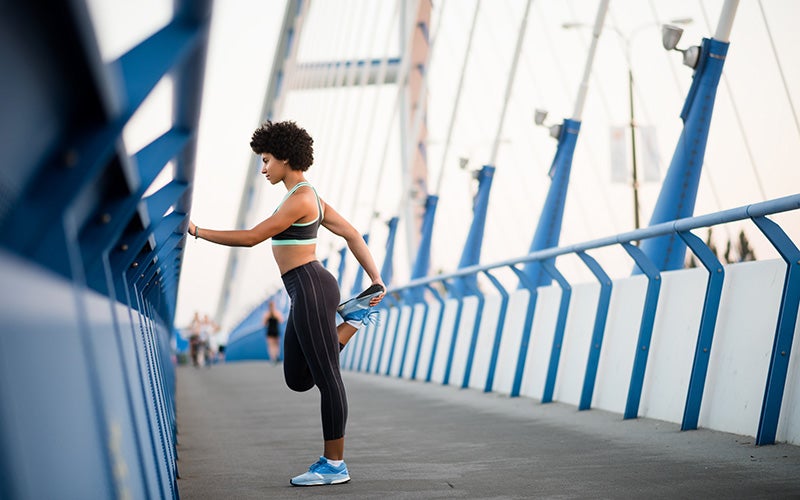 ©Martin Novak
©Martin Novak
Do you really need to warm up before running? And isn’t walking a few more meters enough for a cool-down? Yes and no! Here are some reasons why it’s worth taking the extra time, and a few of our favorite ways to warm up and cool down for runners.
Runners are not always the biggest fans of warming up and cooling down. While most other athletes or fitness lovers would never dream of leaving out a warm-up or cool-down, cold starts and abrupt ends are pretty commonplace for runners. It’s just not right! Every good training plan deserves a warm up and cool down for runners. It gets your body prepared to move, prevents injuries, and initiates regeneration.
Why Warm Up Before Running?
A warm-up before running performs the same basic functions as warming up before any other exercise.
Some of the things you gain from a warm up and cool down for runners:
- Increases your baseline body temperature to stimulate your cardiovascular system
- Improves your blood circulation
- Improves your oxygen uptake
- Improves your muscles’ nutrient supply
- Increases your body’s production of synovial fluid, which cushions your joints
- Improves your coordination and increases your mental focus
All of this results in a lower risk of injury, as well as increasing your potential to run more efficiently, with better running form – which increases your overall performance. After a warm-up, your body will be in running mode and ready to give it your all. With all those benefits, we hope you agree that it’s worth taking those 5-10 minutes before each run.
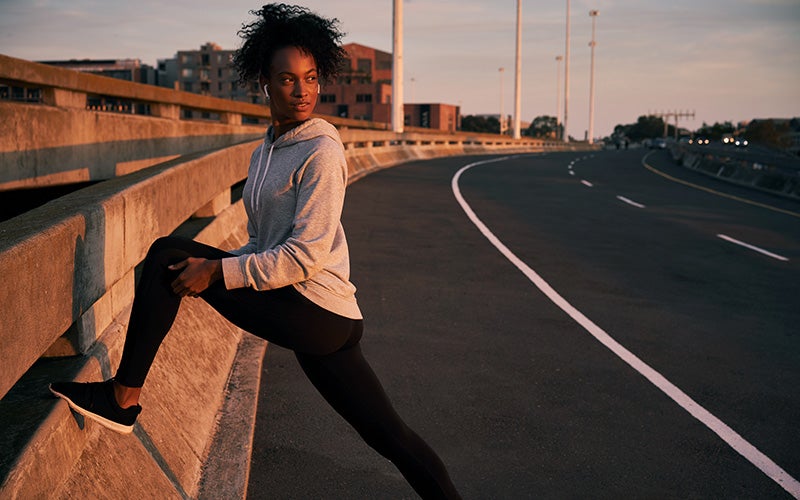
Here’s What to Keep in Mind During Your Warm Up and Cool Down for Runners
The right warm-up for you depends partly on your running level and partly on your goal for your upcoming run. Basically, your warm-up should get you going both physically and mentally, but it shouldn’t wear you out.
What not to do before running? Static stretching. Holding a single stretch for a long time lowers muscle tone – that is, the tension inside your muscles – and robs them of the explosive power you’ll need for a great run.
When planning your warm-up, think about what you want to do: if you’ve got a relaxed jog on the agenda, a light warm-up beforehand is sufficient to slowly bring your body temperature up. If you’re planning a timed run, interval training, or are warming up for a race, a specific warm-up followed by 1 to 2 kilometers of warm-up and a few dynamic warm-up moves will serve you well before you really take off.
Tip: The right nutrition is just as important as the right warm-up. Especially before races, your nutrition is what really gets you ready to cross that finish line.Learn more
Warm Up and Cool Down for Runners: The Best Warm-Up Exercises
These warm-up exercises for runners wake up your whole body, mobilize your joints, and activate your lower body.
When it comes to the right number of reps or length of time for each, there is no clear right or wrong. Start slow and make sure you feel loose but not tired when you start your run. Three to five reps per side for each exercise is a good guideline. That should bring your warm-up routine to at least five minutes.
#1 Ankle circles and stretching with arm circles

Here’s how
- Walk in place. Keeping the balls of your feet on the floor, stretch and bend your ankle. Make large circles with your arms.
- Balance on one leg. Lift the other foot a small distance off the floor and circle your ankles a few seconds in each direction.
#2 Leg Swings Forward and Sideways
Here’s how
- Stand with your legs about hip-width apart. Shift your weight to one leg and swing the other loosely back and forth a few times.
- Then swing it in front of the standing leg from right to left.
- Repeat on the other side.
#3 Squat with Overhead Reach and Forward Bend
Here’s how
- Come into a deep squat and extend both arms next to your ears.
- Keep your back as long and straight as possible, trying to straighten up from the lower back and shifting your weight to your heels.
- Then grab the tops of your feet with your fingers, lift your glutes, and stretch your legs as far as you can, keeping your fingers holding onto your feet.
- Bend your legs again, coming back into the squat with your arms overhead and repeat.
#4 Lunge with Rotation
Here’s how
- Lunge backwards with your right leg. Stay low and find stability, turning your upper body to the left, towards your front leg. Try to keep your legs as stable as possible.
- Step forward and repeat on the other side.
#5 Side Stretch
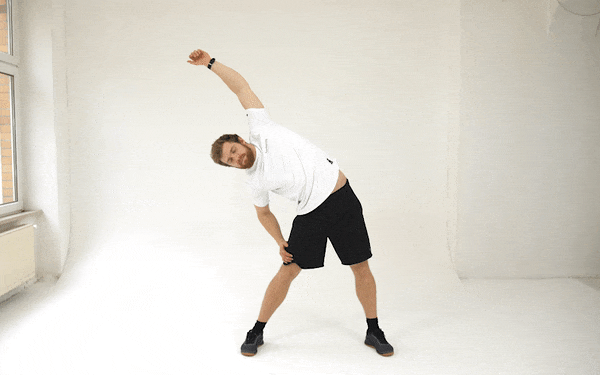
Here’s how
- Stand with your feet wide apart. Push the outer edges of the feet into the floor to keep your knees from buckling inward.
- Alternately stretch out one arm long next to your ear, stretching your body to the opposite side.
- Perform this exercise dynamically, switching sides as soon as you feel the stretch on the other.
- Connect your movement with your breathing: exhaling to the side, inhaling to the center. This will help your heart start to work a little more.
Why Cool Down After Running?
Stop, shower, and head straight to happy hour? Not quite. First the cool-down, then the pleasure. The cool-down is as much a part of it as the warm-up. It gets the mind and body in the right mood for recovery after exertion, helps prevent injuries, and can improve recovery.
The most important benefits of a cool-down for runners are
- improved removal of metabolic waste products like lactate
- gradual slowing of breathing and heart rate reduces the risk of dizziness or lightheadedness
- slow reduction of muscle tension reduces the risk of muscle cramping
- possibly less muscle soreness
Cool Down While Running: Jog It Out, Loosen up, Stretch
Your cool-down actually starts during your run. As you’re wrapping up your run, take enough time to continuously reduce the intensity for a few minutes. Slowing down for the last mile or two is ideal. You can also loosen your shoulders and wrists and let go of some tension.
This also helps you to switch off mentally. Since your body and your mind work as a team, a mental break is just as important to get you into recovery mode.
After that, you should already be reasonably cool when you stop running. Now, static stretching is useful to further reduce the tension in your muscles.
Together with mobility training and fascia training, static stretching helps maintain your mobility as a runner. This is especially important for ambitious athletes who want to stay injury-free in the long run. If you have a few minutes to spare after static stretching, try some foam rolling exercises to keep your fascia and muscles supple.
Too active? For those who like to really zen out after a workout, a sauna session or a hot bath is the perfect addition to a warm up and cool down for runners.
Warm Up and Cool Down For Runners: The Best Cool Down Exercises
These cool-down exercises for runners will get you in the mood for recovery after your run. They relax your muscle tone, especially in the muscles hit hardest by running, and help maintain your overall flexibility.
Perform each exercise on both sides and continue to breathe deeply and evenly the entire time. Try to stand stable and strong and align your joints well. Hold each side for 20-30 seconds.
#1 Standing Quad Stretch
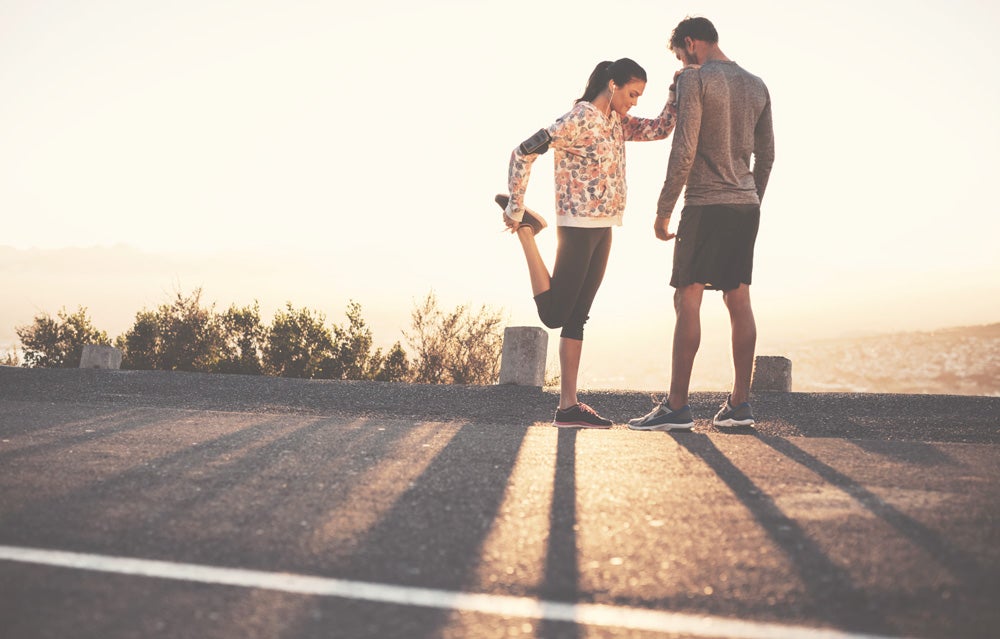
Here’s how
- Find a stable footing, possibly holding onto something with one hand.
- Take a heel to your glutes, grabbing your ankle and gently pulling your thigh back.
- Keep your knees close together, pushing your hips forward.
#2 Hip Flexor Stretch
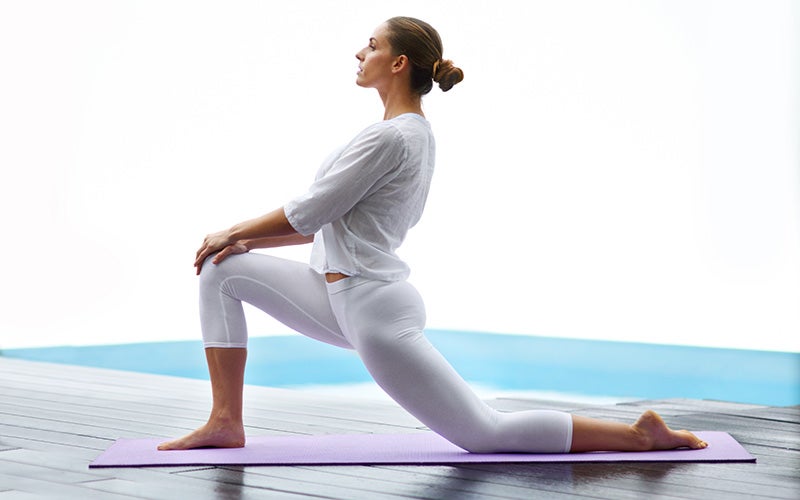
Here’s how
- Lunge backwards and place your back knee on the floor as far back as you can. Place your hands on your front thigh, keeping your front knee directly above your ankle.
- Inhale into the chest and with each exhalation let your hips sink a little further forward.
- Consciously let your shoulders sink back and down. Relax and open your upper body.
#3 Half Side Squat
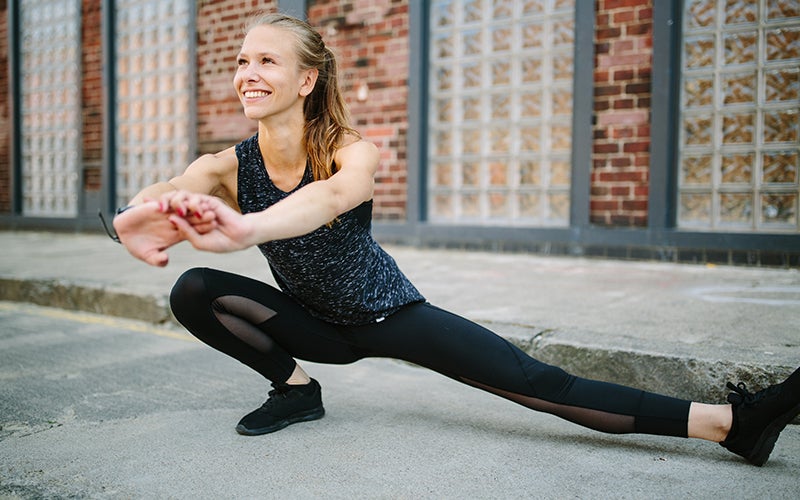
Here’s how
- Stand with both feet wide. Turn your left foot out 45 degrees and bend your left leg as far as you can. Shift your center of gravity to the left until you feel a stretch in the inside of your right leg.
- Make sure that your knee doesn’t collapse inward. If in doubt, support yourself with your hands on the floor.
#4 Standing Calf Stretch
Here’s how
- Find a staircase, sidewalk, or similar elevation. Place the ball of one foot on the edge of the rise and push your heel down until you feel a stretch in the calf.
#5 Side Stretch
Here’s how
- Cross your right leg in front of the left, keeping them close to each other.
- Extend your left leg and bend your front right leg slightly, keeping your weight mainly on the bent leg.
- Stretch your right arm straight up alongside your ear. Slide the right hip to the right and pull your arm over your head towards the left until you feel the stretch through the right side.
- Continue breathing deeply and evenly before repeating on the other side.
Summary
- A proper warm up and cool down for runners help prevent injuries and improve performance.
- Just 5-10 minutes both before and after running is enough to warm up and cool down for runners.
- In addition to having a warm up and cool down for runners, your nutrition before and after your run affects how well you perform.
Sources for this article
We at foodspring use only high-quality sources, including peer-reviewed studies, to support the facts within our articles. Read our editorial policy to learn more about how we fact-check and keep our content accurate, reliable, and trustworthy.





























